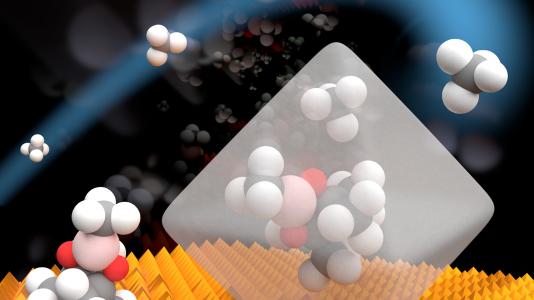
Researchers using the U.S. Department of Energy’s Advanced Photon Source (APS) have found a way to “activate” methane by using a catalyst that is more than 99% selective and so generates very little byproduct, making it potentially useful for a number of applications. Their research was published in Nature Catalysis.
Scientific Achievement
Shale gas and hydraulic fracturing technologies have opened up vast underground and submarine reserves of natural gas, and specifically methane, to petrochemical companies. Rather than simply burning methane for heating, this organic compound can be converted into other useful products: liquid fuels, agrochemicals, pharmaceuticals, polymers, and much more. Unfortunately, methane is not particular reactive, chemically speaking. There are hopes that a particular reaction known as “selective functionalization” could be used to build up more sophisticated molecules from methane for conversion into useful products. The barrier to exploiting this reaction is finding a catalyst that can make the reaction occur quickly without the need of harsh conditions, such as untenable reaction temperatures and pressures or the use of strong acids. When undergoing reaction, catalysts inevitably become damaged, poisoned, and otherwise lose some of the activity with each repeated use. Finding catalysts that are powerful enough to accelerate methane activation and tough enough to be reused might be possible with a particular class of designer compounds known as metal-organic frameworks (MOFs). The unique advantage of using MOF catalysts combines the qualities of a metal catalyst and a porous support with organic chemical components, which can, in some cases, be tailored to have specific shapes and sizes to their pores. The researchers in this study “activated” methane by using a catalyst supported in a MOF.
Significance and Impact
The search for an efficient and effective methane-converting catalyst is considered to be one of the grand challenges facing chemists today. The research at the APS, in combination with inductively coupled plasma atomic emission spectroscopy, showed that the iridium metal atoms in the MOF were present with two atoms per zirconium node in the porous structure. Additionally, the energy-dispersive x-ray analysis showed that the iridium was uniformly present throughout the MOF crystallites. Such chemical details about the catalyst are essential to proving that the catalyst is working in the way the team predicted. Understanding the details of the catalyst’s structure and how it facilitates the chemoselective borylation of methane will allow researchers to fine tune the catalyst and potentially develop related MOFs that could be used to modify methane in other ways. It might also help in the design of MOFs that could be used for entirely different chemical transformation of other small organic molecules.
Research Details
X-ray absorption measurements were carried out on the 10-ID-B insertion device beamline of the Materials Research Collaborative Access Team at the APS.
About the Advanced Photon Source
The U. S. Department of Energy Office of Science’s Advanced Photon Source (APS) at Argonne National Laboratory is one of the world’s most productive X-ray light source facilities. The APS provides high-brightness X-ray beams to a diverse community of researchers in materials science, chemistry, condensed matter physics, the life and environmental sciences, and applied research. These X-rays are ideally suited for explorations of materials and biological structures; elemental distribution; chemical, magnetic, electronic states; and a wide range of technologically important engineering systems from batteries to fuel injector sprays, all of which are the foundations of our nation’s economic, technological, and physical well-being. Each year, more than 5,000 researchers use the APS to produce over 2,000 publications detailing impactful discoveries, and solve more vital biological protein structures than users of any other X-ray light source research facility. APS scientists and engineers innovate technology that is at the heart of advancing accelerator and light-source operations. This includes the insertion devices that produce extreme-brightness X-rays prized by researchers, lenses that focus the X-rays down to a few nanometers, instrumentation that maximizes the way the X-rays interact with samples being studied, and software that gathers and manages the massive quantity of data resulting from discovery research at the APS.
This research used resources of the Advanced Photon Source, a U.S. DOE Office of Science User Facility operated for the DOE Office of Science by Argonne National Laboratory under Contract No. DE-AC02-06CH11357.
Argonne National Laboratory seeks solutions to pressing national problems in science and technology. The nation’s first national laboratory, Argonne conducts leading-edge basic and applied scientific research in virtually every scientific discipline. Argonne researchers work closely with researchers from hundreds of companies, universities, and federal, state and municipal agencies to help them solve their specific problems, advance America’s scientific leadership and prepare the nation for a better future. With employees from more than 60 nations, Argonne is managed by UChicago Argonne, LLC for the U.S. Department of Energy’s Office of Science.
The U.S. Department of Energy’s Office of Science is the single largest supporter of basic research in the physical sciences in the United States and is working to address some of the most pressing challenges of our time. For more information, visit https://energy.gov/science.